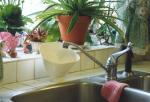Search engine visitors - click here to access entire "$ensible Home" web site
Click here to see a descriptive illustration showing several designs of automatic greywater system/kits.
Dear Jim: We seem to have water shortages every summer and my water/sewage bills keep increasing. Are there any methods or kits available to use household greywater to water the lawn and other landscaping? - Mike M.

A: Reusing greywater in homes is becoming more popular and is one of the most effective methods to stretch our limited water supplies and cut your water/sewage bills. Also, by reusing greywater, load requirements on municipalities' water and sewage treatment facilities are reduced so fewer expensive new facilities are needed.
Greywater from homes refers to waste water from showers, baths, clothes washing, and some sinks. These sources of water are relatively clean and free of chemicals. Water from dishwashers and hand washing or dishes can be used too, but it tends to contain more organic particles, grease and oils.
In the average home, more than half of the water that goes down drains into the sewer is reusable greywater, not black water (from toilets). This typically ranges from 20 to 40 gallons of water per day per family member.
It is relatively simple to use greywater to water shrubs, gardens and trees in your yard. Many companies offer complete kits and systems to capture greywater, store it briefly and then direct it to the plants. Since greywater is still warm, freezing during the winter is not often a problem.
Watering trees and shrubs is often the preferred use of greywater because it can be piped to the roots. This subsurface watering is the most effect and efficient method for plants. The microbes in the soil immediately begin to breakdown on particles, oils, etc. and naturally purify the water.
The simplest method to use is an add-on mini-sink that mounts on your existing kitchen sink. Swing the faucet over it when you rinse vegetables, fruits, your hands, etc. The drain carries water to a simple jug or tank you use for watering. It can also run to an automatic lawn watering system.
Another simple method is called "drain out back" or "branched" greywater. With this system, the greywater simply runs out a pipe in an appropriate location in your backyard. Check your local codes about using this method.
The best greywater systems use large surge tanks to hold the greywater, subsurface drip irrigation emitters, filters, and electronic controllers. These work similar to standard residential lawn/garden water systems except they supplement the city water supply with any available free greywater.
A related item is a waste water heat recovery pipe. This is a new section of drain pipe for your shower. The hot water going down the drain preheats the incoming cold water going to the water heater. This can provide more hot water for morning showers for free.
Instant Download Update Bulletin No. 978 - buyer's guide of nine greywater and heat-recovery water system manufacturers, sizing and payback information, system diagrams, guidelines for choosing a system, chart showing quality of various greywater sources, schematic diagram of an automatic system, and water conservation tips.
Dear Jim: My mother has a brick house that was built in the 1950's. It has real plaster walls with no insulation inside them. Is there a good method to add wall insulation to the walls so they stay warmer? - Joe D.
A: Keeping the walls warmer during the winter is important to feel comfortable in a home. This is particularly true with the elderly who tend to have more problems staying comfortably warm.
Unfortunately, this type of house construction does not provide much room inside the walls to add insulation. You best options are to add exterior foam board insulation or frame out and insulate the wall indoors. Although with this latter option, you will lose floor space.